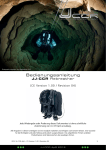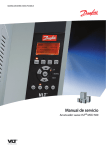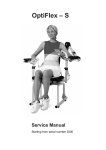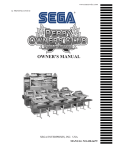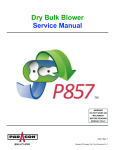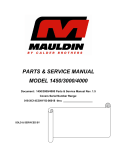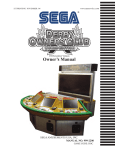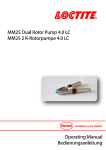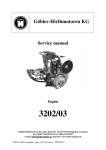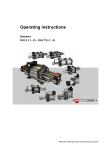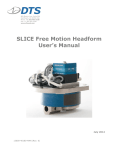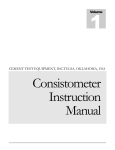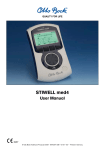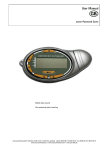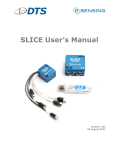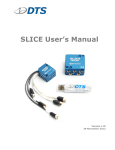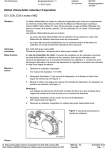Download Model 2000 and 2000-5 UCA Manual.igr
Transcript
1 Volume CEMENT TEST EQUIPMENT, INC. Tulsa, Oklahoma, USA Model 2000 UCA Instruction Manual 1 CEMENT TEST EQUIPMENT, INC. Model 2000 UCA User’s Manual Cement Test Equipment, Inc. 5704 E. Admiral Blvd. Tulsa, OK 74115 Phone 918.835.4454 • Fax 918.835.4475 Rev. F 12.20.10 i Table of Contents Use of the USB Memory Module ................................ 22 INTRODUCTION ...................................... 1 Networking the Instrument. ........................................ 22 What is a UCA used for? .............................................. 1 Transit Time Calibration ............................................ 23 Description of Instrument ............................................. 1 A TOUR OF THE FRONT PANEL CONTROLS ............................................ 25 Instrument Specifications ............................................. 2 Installation ..................................................................... 3 The Hydraulic Pressure Controls ............................... 25 Connecting an Uninterruptible Power Supply (UPS) 5 The Pneumatic Controls .............................................. 26 USING THE TOUCH SCREEN SOFTWARE ............................................. 6 The Electrical and Electronic Controls and Displays27 What is a touch screen and how does it work? ........... 6 OPERATION ........................................... 29 Using the Touch Screen................................................. 6 Preparing the Test Cell ............................................... 29 What can you do with the touch screen software? ..... 7 Setting Up a Temperature Ramp ............................... 30 Navigating the software ................................................ 7 Setting Up Automatic Pressure Control .................... 30 The Main Menu ............................................................. 8 Stopping a Test............................................................. 32 Test Setup Menu .......................................................... 10 Cleaning the Test Cell ................................................. 33 The Main Menu ........................................................... 11 Test Setup Menu .......................................................... 13 MAINTENANCE AND TROUBLESHOOTING ............................ 34 Temperature Control .................................................. 13 Maintenance ................................................................. 34 Instrument Setup Menu .............................................. 15 Troubleshooting ........................................................... 35 Running a Test ............................................................. 18 Parts List and Cross Reference .................................. 38 Stopping a Test ............................................................ 21 i 1 I N T R O D U C T I O N Chapter Introduction This chapter contains general information about the UCA and its uses as well as detailed specifications for the instrument and installation instructions. What is a UCA used for? I C O N K E Y Important information Potential Danger or Safety Hazard C Operational Warning ements are a critical element in the drilling, completion, workover, and abandonment of wells. For each application, a cement slurry is designed with specific properties and is given additives that provide predictable slurry density, volume, viscosity, compressive strength, fluid loss, gas migration, and thickening time. The Model 2000 Ultrasonic Cement Analyzer (UCA) is used to provide a history of the strength development of a cement slurry as it cures under elevated temperature and pressure. Description of Instrument Our temperature controller and data acquisition system are so easy to operate you won’t even need a manual. We’ve thrown one in anyway, just in case. The Model 2000 Ultrasonic Cement Analyzer (UCA) transmits an ultrasonic pulse through a cement slurry and measures the travel time of the pulse through the slurry. The travel time of the pulse through the slurry gives an indication of the compressive strength of the slurry. The compressive strength, along with temperature and pressure, are monitored as a function of time for the purpose of providing a strength history of a setting cement slurry. The major features of the Model 2000 UCA are listed below: Easy to install and use. Direct replacement for Halliburton or Chandler UCA systems. 1 I N T R O D U C T I O N Completely self contained. No need for pressure controllers, control boxes, or PC’s. All software is Windows based. Data may be plotted on a standard ink jet printer, stored on a USB flash memory stick, or archived to an external PC via an Ethernet connection.. Tests are stored as ASCII files and may be retrieved and viewed by most word processors, text editors, spreadsheets, and database programs. Has built in, easy to use, touch screen control panel for control of data acquisition and temperature control. No more clunky temperature controllers to program. Temperature profile is displayed graphically before test starts to reduce mistakes. Available with integral pump and relief valve for soak pressure control. Does not require separate pressure controller. May be used with Halliburton Pressure Controller as an option. Unit may be operated with an optional uninterruptible power supply (UPS) that will keep all functions (except heater) of the UCA operating for up to one hour during power outages. A cross-reference list of Chandler and Halliburton part numbers and equivalent CTE part numbers is provided in Chapter 5, Maintenance and Servicing. Instrument Specifications The specifications below apply to the CTE, Inc. Model 2000 UCA. ELECTRICAL Input Voltage: Input Power: Input Current: Input Frequency: 230 VAC (+15%) 2500W 11 A 50-60 Hz 2 I N T R O D U C T I O N MECHANICAL Height: Width: Depth: Weight: 14.5 in. (36.8 cm) 26 in. (66 cm) 15.3 in. (38.9 cm) 110 lb. (50 kg) ENVIRONMENTAL Operating Temperature: Operating Humidity: (32 to 120 F) 0-50 C 0-95% non-condensing HEATER Heater Power: Heater Type: Heater Control: 2,000 W Cast heater with cooling coils Solid state relay UTILITIES - WATER AND AIR Compressed Air: Cooling Water Pressure: Utility Inlets: 100 psig (6.8 bar) 100 psig (6.8 bar) maximum ¼ inch female NPT Installation Upon uncrating the instrument, verify that the instrument and any spare parts on the packing have been received and are undamaged. Notify CTE if anything is missing or damaged. It is a good idea to leave room behind the instrument so that qualified personnel may have service access. If this is not possible, try to make the unit easy to disconnect and move for service. Once the instrument has been moved to its desired location, air, water, and electrical connections can be made. The air inlet, water inlet, and water drain connections are each ¼ inch female NPT connections and are located on the lower right rear of the instrument. A number of ¼ inch male NPT to 8mm tube fittings are included for international locations. Connect the coolant and pressurizing water to the connectors labeled COOLING WATER and WATER INLET, respectively, on the rear panel of the instrument. Each fitting has a ¼ inch female N.P.T. connection. The water must be clean and free of debris that could cause failure of the pump or relief valve. If in doubt, a water filter is recommended. Connect drain lines to the connectors labeled WATER DRAIN and COOLING DRAIN on the rear panel of the instrument. The fittings have ¼ inch female N.P.T. connections. The drain system must be capable 3 I N T R O D U C T I O N of handling hot water up to 212 F (100 C) or brief surges of up to 400 F (204 C) steam for short periods of time during initial cooling of the instrument. If two or more UCA’s are connected to a common drain line, it is recommended that the drain be 3/8 inch (10mm) inside diameter, minimum. It is also recommended that the drain system be all metal. Connect the air supply to the connector labeled AIR INLET on the rear panel of the instrument. The fitting has a ¼ inch female N.P.T. connection. The air should be dry and relatively free from dirt and oil. The air should be supplied at a pressure of 20-100 psig (1.4-6.8 bar). Compressed nitrogen may also be used in place of the compressed air if necessary. Before plugging the monitor into the rear of the UCA, make certain power to the instrument is off. If high pressure bottles of nitrogen or air are used to operate the instrument, make certain that the pressure supplied to the instrument does not exceed 100 psig (6.8 bar). Applying high pressure gas to the instrument can cause tube rupture and possible injury. Electrical connections are made using the receptacle on the rear of the instrument. A power cord (part number C-0156) is supplied with the instrument. Please observe the following precautions when making the wiring connections. Wiring should be done by a qualified installer in accordance with local electrical codes. The instrument should be securely connected to a separate earth ground. The ground wire must be larger in diameter than the supply conductors An 8BC or larger fire extinguisher to fight electrical and oil fires should be placed within 50 feet of the consistometer. Some components such as touch screen LCD monitors, may be removed from the instrument prior to shipment and shipped in a separate container to prevent damage. This device must be reinstalled before operating the instrument. The monitor cables include one USB and one VGA cable which must be connected to the control box and one AC power cable which must be connected to 110-230 VAC. 4 I N T R O D U C T I O N If a printer is included with the instrument, it may be connected to the control box. Connect the USB connector on the printer cable to the control box. The printer must also be connected to a suitable power source. Refer to the printer documentation for power requirements. If a UPS is not used, the C-0275 cord must be installed between the two rear panel receptacles or the instrument will not operate. Connecting an Uninterruptible Power Supply (UPS) There are two receptacles on the rear of the unit labeled UPS that may be used to connect an uninterruptible power supply (UPS). In the event of a power failure, the UPS will operate all functions of the UCA, except the heater, for up to one hour to prevent loss of test. To connect the UPS, select the power cord supplied with the UPS and connect one end to the UPS input and the other end to the UCA. The cord will fit only one receptacle. Locate the other power cord supplied with the instrument (part number C-0275) and connect one end to the output of the UPS and the other end to the other UPS receptacle on the rear of the UCA. Press the ON button on the UPS. A green light will appear on the UPS when it is operating properly. If the unit beeps and a red light comes on, a power failure has occurred and the unit is being powered by the UPS. Note that if the POWER switch is turned OFF and the UPS is not turned OFF, the instrument will not power down. Before attempting to operate the instrument, it is recommended that the operators read the remainder of the manual and study the drawings that appear in the Drawings/Schematics section of this manual to become familiar with the UCA operation. 5 A T O U R O F T H E F R O N T P A N E L C O N T R O L S 2 Chapter Using the Touch Screen Software This chapter contains specific information on how to use the touch screen software plus instructions on how to network the UCA and connect and use the USB Memory Module. What is a touch screen and how does it work? Touch screens were created to provide operators with an easy to use interface. They allow the user to input and view data without a keyboard or mouse. The touch surface is able to detect contact and send position information back to the processor. Using the touch screen has the same result of using a mouse to point and click. One mouse click is accomplished by one touch of the screen. A doubleclick is achieved with two quick touches. With this standard method of input, no special software is required to utilize the screen. Using the Touch Screen Most any object may be used on the touch-screens. Experimentation will quickly show which objects will activate the screen and which will not. It is important to note the touch surface does NOT use pressure to detect input. A light touch is all that is needed. In addition sharp instruments (such as pencils, pens, screwdrivers, etc.) should not be used as they may damage the touch surface. 6 A T O U R O F T H E F R O N T P A N E L C O N T R O L S What can you do with the touch screen software? The purpose of the touch screen is to provide the user with a single interface to the instrument. Temperature control, instrument setup, and current test data are accessed through the touch screen. This eliminates the need to individually program separate temperature controllers or other off-site PC software to begin running a test. Additionally, the touch screen allows the user to access current information from the instrument during a test. Each instrument is complete and requires no additional software or hardware to function. Navigating the software The software is designed to be intuitive to the user. In addition to the options, the different screens include directions and helpful hints to allow the user to quickly setup and run the instrument. The first-timer will find an easy to follow path to set up a test. Most users will become highly proficient within a very short time. 7 A T O U R O F T H E F R O N T P A N E L C O N T R O L S The Main Menu The main menu is the starting point for the instrument. From here, users may start new tests, setup test parameters, setup instrument parameters, or view an old test. Located at top left is the current temperature reading for the thermocouple. Current pressure is also displayed. The Exit button is used to stop the UCA software and go into the Windows operating system. Please note the software version number underneath the CTE logo. This should consist of a number and perhaps a letter, for example, 5.1b. This version number is important when calling CTE for support or questions. As noted in the instructions on the screen, all the user needs do is touch a button to begin. START TEST – Pressing this button begins a test. The instrument takes the current test parameters and begins a new test. If a temperature profile has been programmed, a screen will prompt the user to turn on 8 A T O U R O F T H E F R O N T P A N E L C O N T R O L S the heater. Once a test has started the main testing screen will be displayed. TEST SETUP – This button takes the user to the Test Setup Screen. Here the user may enter test parameters for the instrument. Test name, cement parameters, UCA algorithm, and Temperature Control are all accessed through this screen. INSTRUMENT SETUP – This button takes the user to the Instrument Setup Screen. From this screen the user may verify transducer signal, calibrate the instrument, or archive the data to a USB memory module or network drive. VIEW TEST – This button allows the user to view any previously stored test. The software looks for the tests in the c:\CTE directory and you will be prompted to select a file. Use care when choosing a file name so you will be able to retrieve it if desired. 9 A T O U R O F T H E F R O N T P A N E L C O N T R O L S Test Setup Menu From this menu the user can setup the parameters for the next test. PROGRAM TEMPERATURE – The Program Temperature button displays the setup screen to enter a temperature profile. This will be discussed further in a later section. 10 A T O U R O F T H E F R O N T P A N E L C O N T R O L S The Main Menu The main menu is the starting point for the instrument. From here, users may start new tests, setup test parameters, setup instrument parameters, or view an old test. Located at top left is the current temperature reading for the thermocouple. Current pressure is also displayed. The Exit button is used to stop the UCA software and go into the Windows operating system. Please note the software version number underneath the CTE logo. This should consist of a number and perhaps a letter, for example, 5.1b. This version number is important when calling CTE for support or questions. As noted in the instructions on the screen, all the user needs do is touch a button to begin. START TEST – Pressing this button begins a test. The instrument takes the current test parameters and begins a new test. If a temperature profile has been programmed, a screen will prompt the user to turn on 11 A T O U R O F T H E F R O N T P A N E L C O N T R O L S the heater. Once a test has started the main testing screen will be displayed. TEST SETUP – This button takes the user to the Test Setup Screen. Here the user may enter test parameters for the instrument. Test name, cement parameters, UCA algorithm, and Temperature Control are all accessed through this screen. INSTRUMENT SETUP – This button takes the user to the Instrument Setup Screen. From this screen the user may verify transducer signal, calibrate the instrument, or archive the data to a USB memory module or network drive. VIEW TEST – This button allows the user to view any previously stored test. The software looks for the tests in the c:\CTE directory and you will be prompted to select a file. Use care when choosing a file name so you will be able to retrieve it if desired. 12 A T O U R O F T H E F R O N T P A N E L C O N T R O L S Test Setup Menu From this menu the user can setup the parameters for the next test. Temperature Control No longer is entering a temperature ramp a confusing process. On the temperature setup screen is a standard numeric keypad. On the left side are three values that define a ramp. Once a ramp is entered the user may advance to the NEXT STEP or press DONE to finish. 13 A T O U R O F T H E F R O N T P A N E L C O N T R O L S When finished, a graph of the desired temperature ramp is displayed. The user may accept the current profile and continue or cancel to make further modifications. Once the first ramp has been entered, press the NEXT STEP button to proceed to the next ramp or DONE to end the profile programming. If you end the programming at this point and start the test the temperature will reach set point and then fall because there was no second ramp or soak entered. From this screen a second ramp may be entered or the user can enter a soak. To initiate a soak the user must use the Soak keypad button in the Ramp Time box. This will tell the computer to hold continuously at the programmed temperature. If you enter Soak as the time, the Start Value temperature and the End Value temperature must be the same. After entering all of your ramps and soak, you may press Done to complete the programming process. If you press Done, a graph will be displayed showing exactly what you have entered for your temperature profile as shown below. From this screen the user may press Accept if the graph is correct or Change to go back to the programming screens to correct any programming errors. If Accept is pressed the TEST SETUP screen will be displayed again. From here press DONE and the main menu will appear. Press START TEST to begin the test or any of the other buttons to change alarm values, slurry type, etc. 14 A T O U R O F T H E F R O N T P A N E L C O N T R O L S ALARM VALUES – The Alarm Values Button allows the user to enter unlimited alarm values for compressive strength and test time. The PC will notify the user when these values have been reached and at what time they were reached. The highest value entered here will become the default AUTOSHUTDOWN value during a test. Instrument Setup Menu From this menu the user can run diagnostics on the ultrasonic transducer circuitry to determine if everything is functioning properly. This menu is also used move the data files from the UCA computer to another PC in order to free space in the UCA memory. ARCHIVE DATA FILES – Select this command to move tests from the UCA to the USB memory module or external ZIP™ Drive. If the instrument reports a ―Disk Full‖ message, it will be necessary to do this before additional tests may be run. After this step is completed, the stored tests on the UCA are moved then deleted. After this button is pressed a message box similar to the one below will appear indicating which files were copied from the UCA to the storage device. 15 A T O U R O F T H E F R O N T P A N E L C O N T R O L S CALIBRATE – The Calibrate button gives the operator the option of calibrating temperature, pressure, or transit time. To calibrate the transit time, the cylinder must be COMPLETELY full of water with no air bubbles inside the cell. Calibration of transit time is discussed in more detail at the end of this chapter. ****NOTE: NEVER CALIBRATE TRANSIT TIME WITH A CEMENT SLURRY OR STEEL BAR FROM OTHER DEVICES 16 A T O U R O F T H E F R O N T P A N E L C O N T R O L S DIAGNOSTICS – The Diagnostics button displays a diagnostic screen where the user may pulse the transducer and display the waveform on the screen. This tool allows the user to quickly verify transducer operation. The peak of the transducer should be well above 200 with water in the vessel. If the pulse amplitude is less than 200 with water in the cell, the UCA will not function properly and an error message will be displayed. 17 A T O U R O F T H E F R O N T P A N E L C O N T R O L S Running a Test Once a test has begun, a RUN-TIME MENU of current values will be shown. The user may control all available parameters of the instrument from this menu. Under the Pressure column, the user can turn the water supply to the pressure vessel on or off and can turn the pump on when the cylinder is filled. Under the Temperature column, the user can select between AUTO and MANUAL temperature control. When in MANUAL mode, the user can adjust the temperature set point as well as turn cooling on/off. Under the Time column, the user can STOP TEST or select SHUTDOWN parameters for the Auto Shutdown feature. The user can select between Time (hr) or Compressive Strength and adjust the target value using the Shutdown Value control. When the test reaches 18 A T O U R O F T H E F R O N T P A N E L C O N T R O L S the Shutdown Value the test will be stopped and cooling automatically turned on. By selecting the VIEW LIVE CHART tab at the top of the screen, the user can view real-time data in chart form. From this screen, the user may print the chart at any time by pressing the PRINT button located at the bottom of the screen. (Please note that a printer must be connected to the instrument before trying to print.) Pressing the PRINT button displays the full TEST VIEWER screen where the user may select specific printing options such as header/footer information before printing to any installed printer. 19 A T O U R O F T H E F R O N T P A N E L C O N T R O L S A complete table of numerical data can also be viewed here by selecting the DATA tab located on the left side of the screen in the Test Viewer. Return to the test controls by selecting CLOSE. This will not have any effect on the actual testing process and can be opened / closed at any time. The VIEW TEST SETUP tab is simply a review of parameters entered during the TEST SETUP and cannot be changed. If there is some question as to whether the instrument is producing the desired ultrasonic waveform, the user may press the VIEW WAVEFORM button. 20 A T O U R O F T H E F R O N T P A N E L C O N T R O L S This will display a waveform similar to the one shown below. IT may take up to a minute for the waveform to be displayed since the software waits for the next pulse to occur. Note that the amplitude of the first waveform peak must be greater than 20 or an error will occur. If the waveform amplitude is less than 20, the instrument may have a faulty cable or ultrasonic transducer or the ultrasonic transducers may not have enough ultrasonic couplant (grease). Stopping a Test To stop the current test, the user must press the STOP TEST button on the RUN-TIME MENU screen. Once the test has been stopped, no further data will be logged and no further temperature control will be provided. You may view the last test or any test stored on the UCA by pressing the VIEW TEST button and selecting the appropriate file name. 21 A T O U R O F T H E F R O N T P A N E L C O N T R O L S Use of the USB Memory Module The UCA operates under a version of the Windows operating system. This allows the use of certain Universal Serial Bus (USB) peripherals, such as USB flash memory modules. These USB memory modules may be used to archive or move UCA test files to another computer. The USB memory modules may be used without special drivers on any Windows XP or Windows 2000 based PC’s. The memory module will simply appear as another disk drive when inserted into the USB port on the PC. To archive the stored tests on the UCA to the memory module, follow the steps below. 1. Connect the memory module to the USB port on the UCA control box. No cables are required. 2. Press the ARCHIVE DATA button on the UCA touch screen. 3. Navigate to the USB drive and select the desired save location on the pop-up window. 4. The files will be copied to the USB memory module and deleted from the UCA. 5. Once the files are copied to the USB memory module they may be moved to a desktop PC. Note that once the UCA data files are archived, they are still longer available for retrieval on the UCA. Deleting files from the UCA must be done manually by selecting the files and moving them to the trash bin in Windows. Networking the Instrument. The UCA may be connected to any Ethernet network (LAN). This makes it convenient to move UCA data files from one computer to another on the network. It is also possible to view a UCA test in progress or an old test from another computer networked to the UCA using the UCA Remote Viewer software. This will allow personnel to view a test in progress from home or on location, provided they have access to the network to which the UCA is connected. 22 A T O U R O F T H E F R O N T P A N E L C O N T R O L S Since the UCA operates under Windows 98 or later, the instrument can be easily connected to a network. It may be necessary to assign an IP address to the instrument in some instances and this can be done in the usual way through the system setup. The UCA should always be kept behind a secure network firewall to prevent unauthorized access via the internet or other portal. Allowing UCA access via the internet is not recommended. Transit Time Calibration Checking the transit time calibration is very easy. Follow the steps below. 1. Fill the cell with water, making certain there is no air trapped in the cell. 2. Apply compressed air pressure of 60-180 psi to the cell. 3. Connect all cables as at the start of a test. 23 A T O U R O F T H E F R O N T P A N E L C O N T R O L S 4. Select CALIBRATE TRANSIT TIME from the touch screen menu. When the calibration screen appears, press the CALIBRATE button. If the waveform appears acceptable, press DONE to save the new calibration values. In general, the peak amplitude should be 600 or greater with water. If an acceptable waveform is not displayed, check the transducers and cables and recalibrate. Transit time calibration is different from older UCA’s. The steel calibration bar is no longer required. The unit is now calibrated with water. It is imperative that there be no air in the water during calibration or while a test is in progress. Incorrect or improper calibration values are the most likely reason for the UCA to report incorrect strength values. The calibration should be checked whenever the transducers are removed or if the compressive strength values become suspect. 24 A T O U R O F T H E F R O N T P A N E L C O N T R O L S A Tour of the Front Panel Controls 3 Chapter Chapter 3 will discuss in detail each front panel control found on the UCA. It may be convenient to refer to the piping drawings in Chapter 6 when studying this section. T he sections below will describe the function of each component found on the front panel. The controls can be divided into three categories: hydraulic controls that control the pressure inside the reservoir, pneumatic controls that control the air pressure to the pump, and the switches that control the electrical components of the instrument. The Hydraulic Pressure Controls This section consists of the following controls: the PRESSURE RELEASE valve, the PRESSURE REGULATOR, the REGULATOR BYPASS valve, and the WATER SUPPLY switch. Components that make up this section are used to control the flow of water used to pressurize the cylinder. The PRESSURE RELEASE valve is used to release pressure from the pressurized cylinder. This valve must be closed during testing except when it is necessary to manually release pressure. This valve must also be closed when removing the pressure vessel with cooling water circulating or cooling water may back up and leak out the pressure port in the top of the instrument. The part number for the PRESSURE RELEASE valve is C-0002-1. The PRESSURE REGULATOR may be used to set the upper limit on the system pressure up to 10,000 psig/680 bar. When the hydraulic force on the regulator exceeds the spring force of the regulator, the regulator valve will open and release pressure until the hydraulic and spring forces balance again. The regulator will then close preventing 25 A T O U R O F T H E F R O N T P A N E L C O N T R O L S any additional pressure release until the hydraulic force again exceeds the spring force. Turn the PRESSURE REGULATOR knob clockwise to increase pressure and counterclockwise to reduce pressure. The use of the pump and PRESSURE REGULATOR to control pressure automatically will be discussed in Chapter 4. The PRESSURE REGULATOR part number is C-0078. The pressure regulator is only usable at pressures up to 10,000 psig/680 bar. If it is necessary to operate the UCA at pressures above 10,000 psig/680 bar, the REGULATOR BYPASS must be turned clockwise to the closed position. For automatic operation at pressures below 10,000 psig/680 bar, the PRESSURE REGULATOR SHUTOFF valve must be turned counterclockwise to the fully open position. The part number for this valve is C-0002-1. The WATER SUPPLY valve is used to control the flow of water to the pump and test cell. This valve must be closed any time the test cell is not installed. This valve must be open to fill the pressure vessel with water or to operate the pump. Opening this valve when the test cell is not connected will cause a serious water leak. The Pneumatic Controls The pneumatic section consists of the AIR TO PUMP gauge and the AIR TO PUMP regulator. The components in this section are used to power the air driven hydraulic pump that applies pressure to the sample. The pressure gauge displays pressure in both English and SI units. The AIR TO PUMP gauge indicates how much air pressure is being supplied to the instrument. The part number for the AIR PRESSURE gauge is C-0138. If there is no pressure indicated on this gauge, the pump will not operate. The pressure should be between 20 and 100 psig (1.4 and 6.8 bar) when the pump is not in use. It is normal for the inlet air pressure to drop when the pump is in operation. If the air pressure drops significantly and the pump seems unable to achieve the desired pressure, it may be because the compressed air system is not capable of delivering enough air to operate the pump. The AIR TO PUMP regulator is used to control the air pressure to the air driven hydraulic pump. Higher hydraulic pressures require higher air pressures. To adjust the pressure of the air supplied to the pump, 26 A T O U R O F T H E F R O N T P A N E L C O N T R O L S pull the knob on the regulator out to unlock it. Turn the regulator knob clockwise to increase the pressure and counterclockwise to decrease the pressure. When the adjustment is finished, push the knob in to lock it in place. The part number of this regulator is C0021. If the PUMP AIR PRESSURE drops off significantly when the pump is operating, an air line may be blocked or the compressor may be insufficient to deliver the volume of air required. This regulator is used to control the pressure of the air supplied to the pump (part number C-0077). The hydraulic pressure output of the pump is directly proportional to the air pressure supplied to the pump. As the air pressure increases, the hydraulic pressures increases and vice versa. Air pressure to the pump may be decreased by turning the AIR TO PUMP regulator knob counterclockwise or increased by turning the knob clockwise. If the regulator is set to a value and the pump switch is turned to the ON position, the pump will increase pressure until the pneumatic force of the air (air pressure multiplied by pneumatic piston area) equals the hydraulic force of the pressurizing water (water pressure multiplied by pump piston area). At this point the hydraulic and pneumatic pressures will be in equilibrium and the pump will cease to stroke. If the water pressure falls for some reason, a force imbalance will be created between the pneumatic and hydraulic sides of the pump and the pump will begin to stroke and increase the hydraulic pressure until it is balanced with the pneumatic pressure, then it will stop pumping. In this way, the pump may be used as a pressure control device (combined with the relief valve) to establish the lower pressure limit for a test. This will be discussed further in Chapter 4. The Electrical and Electronic Controls and Displays The only front panel electrical controls are the POWER, and WATER SUPPLY switches. These controls are discussed in detail below. The switch labeled POWER controls electrical power to the entire instrument. Nothing else is operable if this switch is not on. The part number for the POWER switch is C-0075-1. 27 A T O U R O F T H E F R O N T P A N E L C O N T R O L S The WATER SUPPLY switch is used to supply water to the UCA test cell, pump, and cooling water. This switch should be in the ON position when the instrument is running. 28 O P E R A T I O N 4 Chapter Operation Chapter 4 will discuss in detail the steps required to run a compressive strength test. Examples will be provided when necessary. Preparing the Test Cell The steps that should be used to set up the test cell are listed below. Do not overfill the test cell or cement will be forced into the pressure and/or thermocouple ports and plug them. A small gap between the top and bottom plugs and the cylinder is advisable. Overtightening does not cause better sealing; it only causes plug removal difficulty. 1. Apply a light coating of grease to the inside of the test cylinder, including the top and bottom plug surfaces that are in contact with the cement slurry. Coating the threads will grease or anti-seize lubricant is also recommended. 2. Screw the bottom plug into the bottom of the pressure cylinder. The top of the cylinder is stamped TOP on the wrench flats. 3. Add cement to the test cell until the proper fill level is obtained using the Slurry Level Gauge (P/N 4-0058). The slurry should touch the lower tab marked WET but not the upper tab marked DRY. Be careful not to get cement into the threads. If cement sets up in the threads it may make plug removal and installation difficult or impossible. 4. Gently pour a small amount of water into cylinder on top of the cement--just enough to reach the water fill line on the Slurry Level Gauge. Try not to mix the water and cement. 5. Screw the top plug in place. Do not tighten with a wrench. Hand tight or hand tight less 1/8 turn is optimal. A small amount of water should come out the pressure or thermocouple port when the top plug is in place. 6. Wipe the cylinder assembly clean and gently place in autoclave chamber. Make certain the electrical contacts in the bottom of the cabinet and plug are free from corrosion and debris. Rotate cylinder clockwise if necessary. To insure the banana connection on the bottom the cylinder assembly has good contact, make certain the test cell is pushed down firmly inside the heating 29 O P E R A T I O N jacket. Do not turn the test cell assembly counterclockwise or the plugs may come unthreaded. 7. Connect the one end of the coaxial cable to the BNC connector on the top plug and the other end to the connector on the rear panel labeled TRANSDUCER. 8. Align pressure port in top plug with high pressure fitting on top of autoclave assembly. Rotate test cell in a clockwise direction only. The top or bottom plugs may come unscrewed if the test cell is rotated counterclockwise. 9. Attach the high pressure tube from the cabinet to the test cylinder. Place the U-shaped tube in place. Tighten fittings on both ends of U-tube finger tight only. When the U-shaped tube is in place, complete tightening using a 5/8 inch open end wrench. 10. Connect the thermocouple cable to the connector on the rear of the autoclave labeled J THERMOCOUPLE. 11. Install the thermocouple into the remaining high pressure port in the top plug of the test cell until the fitting is finger tight. 12. Slowly open the water supply valve until water begins to come out the thermocouple connection vent hole. Tighten the thermocouple with a 5/8 inch open end wrench. It is recommended a rag or paper towel be placed near the thermocouple vent hole to collect the spilled water and prevent it from running down inside the instrument or into the sensor cavity. The instrument is now ready to begin a compressive strength test. Setting Up a Temperature Ramp See Chapter 2. Setting Up Automatic Pressure Control This section describes the steps used to control pressure in the Model 2000 UCA. Use of the internal pump and pressure regulator will also be discussed. Follow the steps below the to configure the pump and pressure regulator for automatic pressure control. 30 O P E R A T I O N 1. Make certain the test cylinder is installed properly, the HIGH PRESSURE INLET port on the rear of the instrument (if equipped) is plugged, the PUMP and COOLING WATER is in the ON position in the software and the COOLING WATER is in the OFF position in the software, and the instrument is supplied with compressed air. 2. Turn the AIR TO PUMP regulator clockwise until air pressure is sufficient to raise pressure to the desired pressure set point The air pressure should not exceed 100 psig (690 kPa). 3. Turn the blue PRESSURE REGULATOR knob clockwise until the regulator pressure is sufficient to prevent the regulator from opening at the required pressure set point. 4. Turn the AIR TO PUMP knob clockwise and increase pressure until the pressure exceeds the desired set point. Turn the PUMP switch OFF in the software. Make certain the system is holding pressure before proceeding. The pump contains metal-to-metal inlet and outlet check valves that may not be bubble tight, so a small amount of pressure leakage is to be expected. This should not be a problem under normal operation. 5. Turn the blue PRESSURE REGULATOR knob counterclockwise slowly until the test cylinder pressure begins to drop. Continue turning the regulator knob slowly until the pressure in the test cell is at the upper limit of the desired test pressure. 6. Release pressure in the test cell using the PRESSURE RELEASE valve. 7. Turn the AIR TO PUMP regulator counterclockwise until the AIR TO PUMP is approximately zero. 8. Turn the PUMP switch ON in the software. 9. Slowly turn the PUMP AIR PRESSURE ADJUST regulator knob clockwise until the pump actuates. Continue to slowly turn the regulator knob clockwise until the lower limit for the control pressure is reached. As the test cylinder gets hot, pressure in the test cylinder will increase. When the pressure in the test cylinder exceeds the control pressure upper set point, the pressure regulator will open and pressure will be reduced. If the heating rate is reduced, as during the transition from a temperature ramp to a temperature soak, the pressure in the test cylinder may decrease. If the pressure falls below the control pressure lower limit, the pump will actuate and bring the pressure back within the established limits. 31 O P E R A T I O N The pump and pressure regulator will have hysteresis or a ―deadband‖ in their operation. For example, if the pressure regulator is set to open at 3000 psig, it may open at 3000 psig, but may not close until the pressure falls to some lower value, perhaps 2900 psig. This 100 psig differential between opening and closing is referred to as the deadband or hysteresis. As another example, the pump may be set to actuate if the pressure falls to 3000 psig, but the pressure may reach perhaps 3100 psig before the pump stops. This 100 psig differential between the initial pressure and the final pressure is also known as deadband or hysteresis. If the upper and lower set points are too close together, this deadband may overlap and cause system instability. The system will then go into a continuous oscillation where the pump increases pressure and the pressure regulator releases all the pressure the pump is able to build. The solution to this problem is to decrease the lower set point, raise the upper set point, or both. Stopping a Test When the test has been completed, follow the steps below to end the test. 1. Press the STOP TEST button to manually stop a test. 2. Press the COOLING WATER button to cool the test cell. Use the pump to maintain pressure on the test cell until the cell is cool. When the temperature is below 200 F (93 C) the PUMP switch may be turned to the OFF position and the PRESSURE RELEASE valve opened. Failure to maintain pressure at temperatures above 212 F (100 C) may cause water in the test cell to vaporize into steam. 3. Turn WATER SUPPLY switch to its OFF position 4. To shut-down instrument, press EXIT and confirm. Next, press Windows Start button on bottom left of screen and Shut-down computer properly. 5. Turn POWER switch to its OFF position. 6. Close the PRESSURE RELEASE valve (clockwise). Failure to do so will result in water leakage if cooling water is circulating when the U-tube or thermocouple are loosened. 7. Remove the U-shaped high pressure tubing connecting the test cylinder to the bulkhead fitting on the top of the instrument. 8. Disconnect the transducer cable. 32 O P E R A T I O N 9. Disconnect the thermocouple cable. 10. Lift the test cell from the instrument. The test cylinder is now ready to be cleaned. Cleanup should be done as soon after completion of a test as possible when the sample is easiest to remove. Cleaning the Test Cell When the test cylinder has been cooled and removed from the instrument, it should be cleaned according the following guidelines. The spiral retaining ring found on the bottom plug is used to retain the seal ring and o-ring during disassembly. In some cases, it may make removal of the bottom plug more difficult. Its use is strictly optional and may be omitted if desired. 1. Place the test cylinder in a vice, topside up. The top of the cylinder is marked on the cylinder wrench flats. Use the wrench flats to clamp the plugs and cylinder and do not scratch or nick the cylinder or plugs. 2. Remove the cylinder from the vice and replace in the vice top side down. 3. Unscrew and remove the bottom plug from the test cylinder. 4. Turn the cylinder over and tap the cement sample out of the test cell with a hammer. The cylinder is tapered outward from top to bottom so the cement sample must always be removed through the bottom of the cylinder. 5. Clean the cement and grease from the top and bottom plugs and cylinder. 6. When all traces of cement have been removed, grease the inner surfaces of the test cell, including the seals and o-rings. 7. Replace the o-rings if they were damaged during the test. The test cylinder is now ready to be used for the next test. 33 M A I N T E N A N C E A N D T R O U B L E S H O O T I N G 5 Chapter Maintenance and Troubleshooting This chapter contains information about the necessary periodic maintenance of the instrument as well as common service and troubleshooting guidelines. Maintenance U CA’s can be relatively reliable and trouble free—provided they are serviced and maintained properly. Instruments that are neglected and receive infrequent service or are subject to abuse are certain to cause trouble. The maintenance requirements for UCA are very simple and should consume little time. The first maintenance item is to check and replace the 2 micron filter element inside the high pressure filter housing periodically. The filter housing is located on top of the instrument cabinet and is connected to the high pressure tubing leading to the test cylinder. The filter housing should be thoroughly cleaned at this time. The high pressure filter is designed to prevent cement particles from entering the PRESSURE REGULATOR and damaging it. The second maintenance item is to thoroughly clean and lubricate the test cylinder after every test. Be sure to inspect the o-rings for damage and replace if damaged or severely distorted. 34 M A I N T E N A N C E A N D T R O U B L E S H O O T I N G It is recommended that the thermocouple and water line connections on the top plug be cleaned periodically to prevent buildup of cement in the bore and threads. Problems related to corrosion of the lower transducer connection can be minimized by not allowing water to run down the side of the cylinder and into the bottom of the instrument. Periodically inspect the electrical connector in the bottom of the instrument where the test cylinder rests. If this connector get dirty or corroded, the lower transducer may not make good electrical contact. Clean the connector if necessary. Unlike other UCA’s, it is not necessary to coat the ultrasonic transducers with couplant prior to every test. In fact, the transducers should not be removed unless they are believed to be faulty or unless they need additional couplant. The top transducer is sealed to prevent water from entering the transducer chamber during cylinder filling or cleanup. Troubleshooting The following section consists of a table listing possible remedies for the most common UCA problems. Symptom Cause System builds Leak pressure but will not hold TESCOM Regulator pressure Leaking PRESSURE RELEASE valve is not closed tightly PRESSURE RELEASE valve is worn out. Short circuit is system POWER circuit wiring. breaker switch trips off Faulty POWER switch. Pump strokes PRESSURE RELEASE but little or no valve open, severe leak, pressure is blown rupture disc. obtained Test cylinder has trapped air. WATER SUPPLY valve is not open or water is Remedy Check fittings for leaks and tighten fittings. Rebuild regulator or replace. Close valve tightly. Replace valve stem or entire valve. Disconnect power to instrument and check for short circuits with an ohm meter. Replace switch. Locate problem and correct. Open thermocouple connector slightly and release trapped air. Open WATER SUPPLY valve and check flow of water to the instrument. 35 M A I N T E N A N C E Symptom Instrument not receiving power Heater will not get hot. Temperature display is erratic. Software will not start Pump will not operate. Waveform amplitude is too low A N D T R O U B L E S H O O T I N G Cause not being supplied to the instrument. PRESSURE REGULATOR is not holding pressure. Faulty pump check valve. UPS Jumper not connected or seated properly. Instrument not plugged in. Blown fuse or thrown breaker on circuit supplying power. Blown fuse. HEATER switch not in the ON position. Faulty heater. Faulty solid state relay. Faulty thermocouple. Remedy Turn PRESSURE REGULATOR knob clockwise. Overhaul/replace regulator. Clean and/or overhaul pump check valves. Install UPS Jumper cable to back of instrument, making sure it snaps into place and is fully seated. Connect instrument to the correct power source. Check fuses and breakers on electrical supply circuit. Check fuses on rear panel. Replace any that are blown. Turn HEATER switch to ON position. Replace. Replace. Replace thermocouple. Loose connection in thermocouple wiring. USB Cable unplugged Check for loose wiring and correct if necessary. Ensure that USB from computer to back of instrument is connected. Touchscreen unplugged Check power plug, make sure power or power off button on right side of screen is on. Insufficient air pressure Check air supply and make certain to pump. instrument is supplied with air between 30 and 100 psig. Check air lines for blockage. Adjust PUMP AIR PRESSURE ADJUST regulator to a higher pressure. Solenoid valve If no solenoid click is heard when the controlling flow of air to PUMP switch is turned to the ON pump is not functioning. position, a faulty solenoid valve is likely Not enough ultrasonic Clean transducers and apply new couplant on transducers. couplant. Pea size amount is sufficient. Pressure is below 1000 36 M A I N T E N A N C E Symptom Transit time and compressive strength values are erratic. Water comes out of pump muffler. A N D Cause T R O U B L E S H O O T I N G psi Dirt or debris on transducer faces. Remedy Increase pressure above 1000 psi. Clean transducers and apply new couplant. Not enough ultrasonic Clean transducers and apply new couplant on transducers. couplant. Pea size amount is sufficient. Dirt or debris on transducer faces. Clean transducers and apply new Bad coaxial cable. couplant. Loose coaxial connector Replace cable. inside control box. Check connections and tighten if Pressure was below necessary. 1000 psi during test Check data file and make certain pressure remains above 1000 psi during a test Faulty high pressure Replace the high pressure seal and seal. remove all water from air side of pump. Pump may also be sent back for repair. 37 M A I N T E N A N C E A N D T R O U B L E S H O O T I N G Parts List and Cross Reference The following table contains a list of spare parts for the CTE Model 2000 UCA. A list of equivalent Halliburton and Chandler part numbers is also listed. CTE Part Number Chandler Halliburton Part Number Part Number 4-0080 4-0080-1 Description Pressure Vessel Assembly 80-0010 800.3089 4-0081 Pressure Vessel Assembly Bottom Plug 4-0081-1 80-0013 4-0017 80-0016 4-0017-1 800.30893 Bottom Plug Sealing Ring, CTE Pressure Vessel 800.30894 Sealing Ring, Halliburton Pressure Vessel C-0069 C08564 70.82067 Retaining Ring 4-0014 80-0014 800.30891 Pressure Vessel 4-0082 Top Plug 4-0082-1 80-0011 800.30892 Top Plug 4-0026 80-0019 800.30842 Handle, Top Plug C-0074 C08565 70.34027 O-Ring, Viton, 75 duro C-0074-1 O-Ring, Viton, 90 duro C-0681 O-ring, 2000-5 LP UCA C-0138 Gauge, Pressure, 160 psi C-0077 Pump C-0077-1 P-3263 Pump C-0078 C08581 Pressure Regulator C-0079 C08582 Bulkhead Fitting, 1/4 HPT-1/4 HPT 38 M A I N T E N A N C E A N D T R O U B L E S H O O T I N G CTE Part Number Chandler Halliburton Part Number Part Number Description C-0254 P-2189 Valve, 60000 psi C-0002-1 4-0032 Valve, 30000 psi 80-0022 800.30813 4-0058 Heating/Cooling Jacket, 2000 W Slurry Level Gauge C-0379 C08566 70.83164 Spring, .72 x .072 x 3.00 4-0035 80-0026 800.30824 Heating Jacket Centering Ring 4-0023 80-0024 800.30823 Heating Jacket End Gasket 4-0037 Heating Jacket Bottom Gasket 4-0085 Transducer Retainer, Top 4-0087 Spacer, Compression, Spring, Top C-0080 SSR, 240 VAC, 25A, DC Control C-0132 P-3330 70.80037 SSR, 240 VAC, 25A, AC Control C-0561 C08570 70.49981 Spring C08606 70.76017 Adapter, BNC, Male-Male C-0242 P-2610 70.23701 Fuse, 1/4 A, 250 V, MDL-1/4 C-0266 P-3359 70.73543 Inlet, Electrical, 20 A, 250 VAC 4-0021 80-0021 800.30843 Thermocouple, Type J, 20000 psi C-0516 Thermocouple, Type J, 5000 psi C-0371 C08584 C-0558 P-0317 70.75933 C-0024 Sensor, Ultrasonic, High Temp Solenoid Valve C-0075 P-3388 C-0264 C08572 Switch, ON/OFF Circuit Breaker, 10A 80.31035 Thermostat, 420 Open/380 Close 39 M A I N T E N A N C E A N D T R O U B L E S H O O T I N G CTE Part Number Chandler Halliburton Part Number Part Number Description C-0003 P-1075 High Pressure Filter Assembly C-0081 C08590 Rupture Disc C-0096 Pressure Transducer C-0139 Nylon Bushing C-0140 Flanged Nylon Bushing C-0141 Knob, Threaded C-0172 Printer Cable C-0324 Fan C-0358 Filter Element, 2 micron C-0467 Fuse, 20A C-0481 Power Supply C-0156 Power Cord 4-0065 Cylinder Wrench C-0336 Touch Screen Power Supply C-0145 Monitor, Touch Screen 40 Transit Time Calibration. Checking the transit time calibration is very easy. Follow the steps below. 1. Fill the cell with water, making certain there is no air trapped in the cell. 2. Apply pressure of 1000 psi or more to the cell. This will collapse any tiny air bubbles that may be present. It is not absolutely necessary to apply pressure, but experience has shown that this is the best way to ensure no air bubbles are present. 3. Check the transducer waveform as described on p. 14 and make certain that the amplitude of the peaks is greater than +600 and less than –600 with water (it may be less with cement). 4. If the waveform appears acceptable (greater than +600 and less than –600), keep water in the cell with more than 1000 psi and check the transit time by starting a test. The transit time value should be between 17.0 and 17.2 microseconds (msec). If it is within these values, the transit time calibration is correct. 5. If the transit time falls outside these limits, recalibration will be necessary. Follow the instructions below. Transit time calibration is different from older UCA’s. The steel calibration bar is no longer required. The unit is now calibrated with water. It is imperative that there be no air in the water during calibration or while a test is in progress. The easiest way to insure this is to apply 1000 psi or more to the cell during calibration. The calibration screen will also not tell whether the calibration is valid. This can only be determined using the method described above. Rather, the calibration screen forces whatever waveform it records to be (by definition) that of water with a transit time of 17.104 micro-seconds. For example, if a calibration is done with the coax cable disconnected, the instrument will store the flat line signal as that of water and it will report the transit time to be 17.104 micro-seconds. This is not the correct waveform for water and when the calibration is checked according to the above procedure, the instrument will not report the correct transit time. Follow the steps below when calibration is required. 1. Fill the cell with water, making certain there is no air trapped in the cell. 2. Apply pressure of 1000 psi or more to the cell. 3. Check the pulse as described earlier and make certain the waveform has sufficient amplitude. 4. If the waveform appears acceptable, enter the Calibration screen and follow the directions. This will store a new calibration file for water in the instrument memory. Again, this will force the waveform stored in memory to be 17.104 micro-seconds by definition. 5. Exit the calibration screen. 6. Start a test (keep water in the cell with more than 1000 psi) and check the transit time. The transit time should display 17.104 or be very close to this value. If the transit time is outside the range of 17.0-17.2, then repeat steps 3-6. 7. If the transit time is in agreement, the instrument is calibrated properly. If not, repeat steps 3-6. Incorrect or improper calibration values are the most likely reason for the UCA to report incorrect strength values. The calibration should be checked whenever the transducers are removed or if the compressive strength values become suspect. 8 7 4 5 6 3 2 1 REVISIONS THE INFORMATION CONTAINED IN THIS DRAWING IS THE SOLE PROPERTY OF CEMENT TEST EQUIPMENT, INC. ANY REPRODUCTION IN PART OR WHOLE WITHOUT THE WRITTEN PERMISSION OF CEMENT TEST EQUIPMENT, INC. IS PROHIBITED. REV. DATE DESCRIPTION APPROVED 12 D D 5 1 9 10 2 10 9 4 4 3 18 15 C 7 C 8 14 11 6 17 ITEM NO. QTY. 1 1 2 1 3 1 4 2 5 1 6 1 7 1 8 1 9 2 10 2 11 1 12 2 13 1 14 1 15 1 17 1 18 1 19 2 20 1 13 B 19 20 19 SECTION A-A SCALE 1 : 1 12 UNLESS OTHERWISE SPECIFIED DIMENSIONS ARE IN INCHES TOLERANCES ARE: A FRACTIONS 1/32 DECIMALS .XX .01 .XXX .005 ANGLES 1 CAD GENERATED DRAWING, DO NOT MANUALLY UPDATE DRAWN CHECKED FINISH USED ON APPLICATION 8 7 6 5 4 DO NOT SCALE DRAWING 3 MFG ENG QUAL ENG B A CEMENT TEST EQUIPMENT, INC. CCD 6-11-99 CCD 6-11-99 RESP ENG DESCRIPTION CYLINDER BOTTOM PLUG TOP PLUG ULTRASONIC TRANSDUCER HEATER TABLE BANANA JACK JACK SUPPORT JACK INSULATOR SEAL RING O-RING CONNECTOR BASE HANDLE PLUG HOLDER BANANA JACK PLUG INSULATOR O-RING (NOT SHOWN) O-RING (NOT SHOWN) RETAINING RING (NS) SPRING (NOT SHOWN) DATE APPROVALS MATERIAL NEXT ASSY PART NO. 4-0014 4-0081 4-0082 C-0371 4-0036 4-0089 4-0085 4-0086 4-0017 C-0074 4-0088d 4-0026 4-0083 4-0087B 4-0084b C-0753 C-0127 C-0069 C-0395 CCD 6-11-99 CCD 6-11-99 CCD 6-11-99 2 UCA CYLINDER ASSEMBLY SIZE DWG. NO. B SCALE REV. 4-0080 C SHEET 1 OF 1 CAD FILE: 1 C-0167 CONNECTOR 1 2 3 4 WHITE + RED 0-HEATER, 1-COOLING H20, 3-PUMP TOH 3 5-H20 FILL TOL 4 3 4 1 2 USB C-1189 C-1190 USB USB +12V MEASUREMENT COMPUTING C-1181 2 + - D5 D5 + 43 33 GREEN BLACK ORANGE BROWN WHT/BLACK WHT/RED BLACK D0 D0 D1D1 D3D3 + - + - + 48 49 4749 4539 C-0089-18 STRAIN RELIEF BLACK H20 SWITCH C-489 RED PRESS TRANSDUCER C-0096 4 5 6 7 4 5 RELAYS C-1261 #3 #2 6 TOP WHT/RED WHITE RELAY BOARD C-1260 3 04-0203 UCA PULSA BOARD C-1183 PANEL +5-5 C-0481 WHT/BLUE POWER SUPPLY -5-2 WHT/ORANG L3 +12-3 WHT/PURP L2 -12-1 WHT/BLK L1 COM-4 CABLES C-0352, C-0845 C-1183/C-1186 PINOUTS 1-WHT/RED 2-WHT/BLUE 3-WHT/ORANGE 4-WHT/PURPLE URPLE 5-WHT/BLK BOTTOM BULKHEADS C-0770 7 C-0089-11 Heater Protection Board 10 C-1186 CABLE V0H V0L + 38 37 BLACK #1 2 GND CABLE C-0362 GREEN 3 V5 UCA CONTROL BOX C-0089-19 NANO LX CPU 1-WHITE 2-RED 3-GREEN 4-BLACK 10 04-0021 T/C FAN C-1151 TOP TRANSDUCER - + BULKHEAD C-0770 C-0264 THERMOSTAT PRESSURE VESSEL C-0080 5 4 1 Power Switch C-0075 WATER FILL C-0024 3 2 RED C-0472 TERMINAL BLOCK Power Inlet C-0271 RED POWER AC 230 VOLTS 20 AMPS 50/60 HZ Line Load YELLOW BOTTOM TRANSDUCER C-0080 4 4 1 PUMP C-0024 C-0272 3 2 5 5 UPS OR C-0275 YELLOW C-0472 TERMINAL BLOCK C-0271 COOLING WATER C-0024 Ultrasonic Cement Analyzer with External Control Box HEATER 4-0032 Cement Test Equipment, Inc DRAWN BY GRH 10-07-09 PROJECT NO Version 5.0 Control Box APPROVED BY REV DATE BY CHK DESCRIPTION APPROVED BY APPROVED BY REVISIONS DRAWING NO 4-0008 V5 G 0 0 5 10 15 8 6 7 4 5 3 2 1 REVISIONS THE INFORMATION CONTAINED IN THIS DRAWING IS THE SOLE PROPERTY OF CEMENT TEST EQUIPMENT. ANY REPRODUCTION IN PART OR WHOLE WITHOUT THE WRITTEN PERMISSION OF CEMENT TEST EQUIPMENT IS PROHIBITED. REV. PUMP AIR PRESSURE DATE APPROVED AIR SUPPLY 32 F DESCRIPTION F 30 30 29 31 29 19 27 28 COOLING WATER 28 TEE 20 22 22 36 E E 34 HEATING/ COOLING COIL HEATING/ COOLING COIL 19 31 31 22 22 WATER SUPPLY 33 31 D D ITEM NO. PRESSURE VESSEL 16 21 RELIEF VALVE SHUTOFF PRESSURE RELEASE C 12 12 18 15 14 20 14 26 8 9 10,000 PSI 7 PUMP 37 13 TOP PANEL 1 B 33 17 23 9 8 38 25 11 1/8 SST 1/4 SST 9 8 1/4 COPPER 1/4 PLASTIC (BLUE) 24 A 10 2 6 4 2 4 QTY. 5 PART NO. 2 C-0079 C-0029 DESCRIPTION BULKHEAD CONNECTOR BULKHEAD CONNECTOR 3 4 5 1 4-0056 5 C-0399 1 C-0838 ANTI-ROTATION BRACKET BULKHEAD FASTENER CROSS, 1/4 HP 6 7 8 1 C-0146 1 C-0003 3 C-0049 SAFETY HEAD FILTER, HP COLLAR, 1/4 HP 9 10 11 12 3 1 2 2 GLAND, 1/4 HP PRESSURE TRANSDUCER TEE, 1/4 HP VALVE, HP 13 14 15 1 C-0575 2 C-0027 1 C-0259 PUMP ADAPTER, 1/4 HP x 1/8 FNPT ELBOW, 1/8T x 1/4 MNPT 16 17 18 1 C-0078 1 C-0262 1 C-0262 RELIEF VALVE TEE, BRANCH 19 20 21 2 C-0056 2 C-0054 1 C-0182 22 23 24 4 C-0778 1 C-0051 1 C-0081 VALVE, BRS ELBOW, 1/4T x 1/8 MNPT CONN, 1/4T x 3/8 MNPT ElLBOW,UNION, 1/4 T x 1/4T TEE, UNION RUPTURE DISC, 22000 PSI 25 26 27 1 C-0263 1 C-0284 1 C-0178 CONN, 1/8 MNPT x 1/4T 28 29 30 2 C-0184 2 C-0205 2 C-0138 TEE, 1/4 T x 1/8 MNPT ADAPTER,1/8 FNPT x 1/8 FNPT PRESSURE GAUGE 31 32 33 3 C-0180 1 C-0021 3 C-0181 ELBOW, 1/4T x 1/8 MNPT REGULATOR ELBOW, 1/4T x 1/4 MNPT 34 35 36 1 C-0024 1 C-0148 1 C-0830 VALVE, SOLENOID PLUG, HP PLUG, BRS 37 38 1 C-0357 1 C-0838 ADAPTER MEDIUM PRESSURE CROSS C-0050 C-0096 C-0839 C-0002-1 39 1/4 PLASTIC (BLACK) 4 2 4 WATER OUTLET WATER INLET PARTS LIST UNLESS OTHERWISE SPECIFIED DIMENSIONS ARE IN INCHES TOLERANCES ARE: LOWER REAR PANEL 7 6 5 CAD GENERATED DRAWING, DO NOT MANUALLY UPDATE FRACTIONS DECIMALS ANGLES 1/32 APPROVALS .XX .XXX .01 1 DRAWN CCD .005 CEMENT TEST EQUIPMENT DATE 1-12-98 CHECKED MATERIA L COOLING COOLING INLET OUTLET CCD 1-12-98 CCD 1-12-98 CCD 1-12-98 CCD 1-12-98 UCA PIPING SCHEMATIC RESP ENG FINISH NEXT ASSY 4 3 2 MFG ENG USED ON APPLICATION 8 B BUSHING ELBOW, 1/8T x 1/8 MNPT 2 AIR INLET C 1 2 DO NOT SCALE DRAWING SIZE REV. DWG. NO. 4-0007 D QUAL ENG SCALE CAD FILE: 1 C SHEET 1 OF 1 TOUCHSCREEN COAX TO CONTROL BOX "BOTTOM TRANSDUCER" MAIN POWER POWER VGA USB "DATA TRANSFER CABLE" POWER TO CONTROL BOX USB THERMOCOUPLE "ORIENTATION SPECIFIC CONNECTOR" UPS "UNIVERSAL POWER SUPPLY" ; OPTIONAL FOR THE INSTALLATION OF UPS FOR POWER OUTAGE OR SURGES. IF NO UPS, USE SUPPLIED CABLE FOR "JUMPER". PRINTER 10 USB POWER 10 UCA INSTRUMENT "BACK PANEL" 4 PORT USB HUB "SUPPLIED" KEYBOARD USB COM 1 "NOT USED" MEMORY STICK FOR DATA STORAGE/TRANSFER "SUPPLIED" VGA "TOUCH SCREEN" ETHERNET "NETWORK" USB CONNECTORS 6 PIN MINI DIN "NOT USED" TOP BOTTOM TRANSDUCER TRANSDUCER CABLE CABLE COMPACT FLASH CARD "COMPUTER MEMORY, DO NOT REMOVE" POWER FROM UCA INSTRUMENT 5 5 COMPUTER CONTROL BOX "BACK PANEL" THERMOCOUPLE 230 VOLT 50/60HZ POWER SOURCE 110 OR 230 VOLT 50/60HZ POWER SOURCE TOP TRANSDUCER UCA VERSION 5 PERIPHERALS INSTALL GUIDE Cement Test Equipment, Inc PRESSURE VESSEL DRAWN BY APPROVED BY REV DATE BY CHK DESCRIPTION APPROVED BY APPROVED BY REVISIONS GRH 03-27-2010 GRH GRH 03-27-2010 GRH 03-27-2010 03-27-2010 PROJECT NO DRAWING NO UCA PERIPHERALS INSTALL GUIDE 0 0 5 10 15 MAXIMATOR® MAXIMATOR GmbH 37449 Zorge, Walkenrieder Str. 15, Tel.: ++49 (0) 5586 803 0, Fax: ++49 (0) 5586 803 40 e-mail: [email protected], website: www.maximator.de Technische Änderungen vorbehalten MAXIMATOR® ============================================================================ MAXIMATOR. GmbH 23.09.2004 VP 10.00.127.05 Seite: 1 / 3 :Pos :Anz: Benennung : Bemerkung : Artikel-Nr :Zeichnungs-Nr ============================================================================= :1 : 1 :Top cap :PP ... - 01( - HL) :3610.4094 :VP 10.02.107 --------------------------------------------------------------------------:2 : 1 :O-ring : :3660.0151 :OR 70.11.42.01 --------------------------------------------------------------------------:3 : 1 :Bushing :PP ... - 01 (- HL) :3610.4095 :VP 10.02.108 --------------------------------------------------------------------------:4 : 1 :Spool housing :G3/8 :3610.0106 :VP 10.01.06 --------------------------------------------------------------------------:5 : 1 :Spool sleeve : :3610.0105 :VP 10.01.05 --------------------------------------------------------------------------:6 : 3 :O-ring : :3660.0111 :OR 60.01.62.01 --------------------------------------------------------------------------:7 : 1 :Spool : :3610.0110 :VP 10.01.02 --------------------------------------------------------------------------:8 : 4 :O-ring : :3660.0505 :OR 80.08.39.01 --------------------------------------------------------------------------:9 : 3 :O-ring : :3660.0109 :OR 70.01.42.01 --------------------------------------------------------------------------:10 : 2 :O-ring : :3660.0112 :OR 70.01.72.01 --------------------------------------------------------------------------:11 : 1 :Spool plug : :3610.0104 :VP 10.01.04 --------------------------------------------------------------------------:12 : 1 :Snap ring : :3610.0109 :VP 10.01.10 --------------------------------------------------------------------------:13 : 2 :O-ring : :3660.0103 :OR 70.00.82.01 --------------------------------------------------------------------------:14 : 4 :O-ring : :3660.0106 :OR 70.01.12.01 --------------------------------------------------------------------------:15 : 3 :Head socket screw : :3610.0107 :VP 10.01.07 --------------------------------------------------------------------------:16 : 1 :Muffler : :3610.0108 :VP 10.01.09 --------------------------------------------------------------------------:17 : 1 :Pilot screw : :3610.0127 :VP 10.02.04 --------------------------------------------------------------------------:18 : 1 :Gasket : :3610.1264 :VP 10.18.49 MAXIMATOR GmbH 37449 Zorge, Walkenrieder Str. 15, Tel.: ++49 (0) 5586 803 0, Fax: ++49 (0) 5586 803 40 e-mail: [email protected], website: www.maximator.de MAXIMATOR® ============================================================================ MAXIMATOR. GmbH 23.09.2004 VP 10.00.127.05 Seite: 2 / 3 :Pos :Anz: Benennung : Bemerkung : Artikel-Nr :Zeichnungs-Nr ============================================================================= :19 : 1 :Spring : :3610.0130 :VP 10.02.07 --------------------------------------------------------------------------:20 : 1 :Pilot tappet : :3610.3180 :VP 10.02.47 --------------------------------------------------------------------------:22 : 1 :Seal : :3610.3181 :VP 10.02.48 --------------------------------------------------------------------------:23 : 1 :O-ring : :3660.0843 :OR 70.01.24.01 --------------------------------------------------------------------------:24 : 1 :O-ring : :3660.0221 :OR 70.715.15.01 --------------------------------------------------------------------------:25 : 1 :Air cylinder : :3610.0178 :VP 10.03.15 --------------------------------------------------------------------------:26 : 1 :Plunger :PP 189 :3610.0147 :VP 10.03.02 --------------------------------------------------------------------------:27 : 1 :Air piston :PP ... :3610.0157 :VP 10.03.07 --------------------------------------------------------------------------:28 : 1 :O-ring : :3660.0207 :OR 70.23.22.01 --------------------------------------------------------------------------:29 : 1 :Plunger bracket : :3610.0191 :VP 10.03.27 --------------------------------------------------------------------------:30 : 1 :Spring : :3610.0181 :VP 10.03.18 --------------------------------------------------------------------------:31 : 1 :O-ring : :3660.0108 :OR 70.01.32.01 --------------------------------------------------------------------------:32 : 1 :Bottom cap :PP ... - HL :3610.0203 :VP 10.04.01 --------------------------------------------------------------------------:33 : 1 :Vent cap : :3610.0205 :VP 10.04.03 --------------------------------------------------------------------------:34 : 1 :Pumphead :PP 189 - HL :3610.0403 :VP 10.05.56 --------------------------------------------------------------------------:35 : 1 :Seal :PP 189 :3610.0492 :VP 10.06.40 --------------------------------------------------------------------------:36 : 1 :Back up :PP 189 :3610.0432 :VP 10.06.01 --------------------------------------------------------------------------:37 : 1 :Base ring :PP 189 :3610.0438 :VP 10.06.06 MAXIMATOR GmbH 37449 Zorge, Walkenrieder Str. 15, Tel.: ++49 (0) 5586 803 0, Fax: ++49 (0) 5586 803 40 e-mail: [email protected], website: www.maximator.de MAXIMATOR® ============================================================================ MAXIMATOR. GmbH 23.09.2004 VP 10.00.127.05 Seite: 3 / 3 :Pos :Anz: Benennung : Bemerkung : Artikel-Nr :Zeichnungs-Nr ============================================================================= :38 : 1 :Lock nut : :3610.0444 :VP 10.06.12 --------------------------------------------------------------------------:39 : 1 :Cap nut : :3610.0443 :VP 10.06.11 --------------------------------------------------------------------------:40 : 2 :Ball bracket : :3610.0397 :VP 10.05.50 --------------------------------------------------------------------------:41 : 2 :Spring : :3610.0399 :VP 10.05.52 --------------------------------------------------------------------------:42 : 2 :Ball : :3610.0358 :VP 10.05.16 --------------------------------------------------------------------------:43 : 1 :Inlet gland :3/8NPT :3610.0420 :VP 10.05.69 --------------------------------------------------------------------------:44 : 1 :Outlet gland :9/16-18UNF :3610.0424 :VP 10.05.71 --------------------------------------------------------------------------:45 : 1 :Mounting bracket (bottom) : :3610.0182 :VP 10.03.19 --------------------------------------------------------------------------:46 : 4 :Hex head screw : :3610.1069 :VP 10.15.02 --------------------------------------------------------------------------:47 : 2 :U-Washer : :3610.0185 :VP 10.03.21 --------------------------------------------------------------------------:48 : 4 :Spring washer : :3610.0184 :VP 10.03.20 --------------------------------------------------------------------------:50 : 1 :Pumphead w. side inlet :Optional type: PP 189S - HL :3610.0405 :VP 10.05.58 --------------------------------------------------------------------------:51 : 1 :Cover plate :drop at PP 189 - HL ! :3610.0128 :VP 10.02.05 --------------------------------------------------------------------------:52 : 1 :Hex head screw :drop at PP 189 - HL ! :3610.0129 :VP 10.02.06 --------------------------------------------------------------------------:53 : 1 :Adapter :1/4NPT :3620.0160 :VP 15.02.32 --------------------------------------------------------------------------:54 : 1 :O-ring : :3660.1112 :OR 70.04.46.01 --------------------------------------------------------------------------- MAXIMATOR GmbH 37449 Zorge, Walkenrieder Str. 15, Tel.: ++49 (0) 5586 803 0, Fax: ++49 (0) 5586 803 40 e-mail: [email protected], website: www.maximator.de MAXIMATOR® MAXPRO Änderungsprotokoll MAXPRO Record of changes Typ: Type: PP 189(S) – 01(-HL) Zeichnungs-Nr.: Drawing-No. VP 10.00.127.05 Artikel-Nr.: Ident-No. 3810.0192 / 3810.0170 Änderungsdatum: Date of change 23.09.2004 Änderungshinweise: Change directions - HD-Dichtsatz war VP 10.13.129.01 (3610.0808) ersetzt durch HD-Dichtsatz VP 10.13.129.05 (3610.0812) - HP-seal kit VP 10.13.129.01 (3610.0808) removed through HP-seal kit VP 10.13.129.05 (3610.0812) MAXIMATOR GmbH 37449 Zorge, Walkenrieder Str. 15, Tel.: ++49 (0) 5586 803 0, Fax: ++49 (0) 5586 803 40 e-mail: [email protected], website: www.maximator.de
























































